THE ALTA ENVIRONMENTAL CENTER RELEASED ITS ANNUAL REPORT ON CONSERVATION AND SUSTAINABILITY EFFORTS.
Download the 2021 Sustainability Report
where we begin: land conservation
It All Starts with a Seed
From the time the snow starts to melt off of Alta’s slopes in late spring up until the snow flies again in the fall, it is go time for the Alta Environmental Center (AEC). Each summer, plant and tree seedlings are planted all over the mountain, over 100 acres are surveyed and treated for invasive and noxious species, and seed is harvested to grow next summer’s plants and trees. This summer:
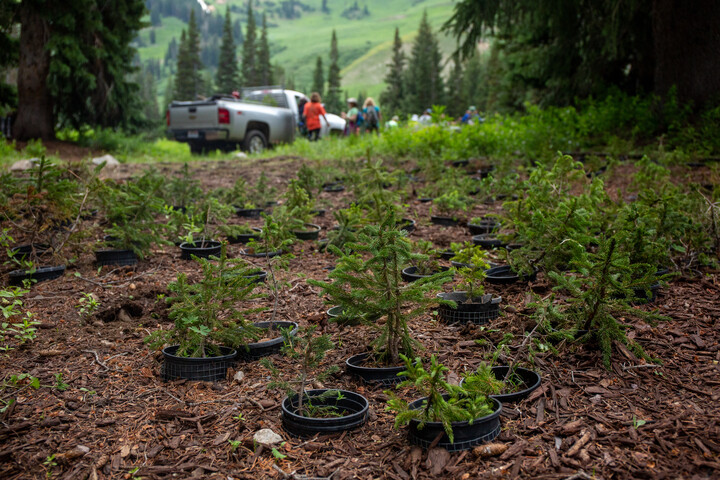
- 5,480 native plant seedlings were planted in areas where there has been recent disturbance and in areas that are in need of ongoing restoration, such as heavily impacted base areas.
- 1,000 Douglas fir tree seedlings were planted around the mountain.
- Seed from 18 different plant species was gathered to grow next summer’s plants.
- 100 acres of land surveyed and treated for noxious and invasive species.
Saving Some for Later
In addition to growing native plants from seed, the AEC partners with non-profit group, TreeUtah, to salvage saplings that are growing in the middle of groomed ski runs. During the summer, volunteers head out on the hill to help us find these small trees, carefully remove them with their roots, and put them into the AEC’s onsite tree nursery. Here, they will wait for about a month or so before we plant them into safer places on the mountain. Trees that grow naturally in the middle of groomed ski runs don’t have much of a chance once they reach a few feet in height - they will be crushed by grooming equipment. Our goal is to save some of these trees and hopefully give them a much better chance of survival elsewhere. Thank you to TreeUtah for their expertise and guidance in this effort!
Forest Health
As stewards of the land that we operate on under our special use permit, we work with Forest Service specialists on how to best manage Alta’s forest resources. Alta meets every so often with the Forest Service’s Forest Health Protection staff based in Ogden, Utah, to conduct forest health field assessments and discuss evolving management direction of forest resources.
There are many different factors affecting forest health throughout the Wasatch Range including infestations by beetles and insects, root rot, and other diseases and fungus. Different types of beetles and insects have been a significant cause of tree mortality and different levels of tree damage throughout the Wasatch Range. The most problematic pests observed at Alta include the western balsam bark beetle (Dryocoetes confucius [Swaine]), the spruce beetle (Dendroctonus rufipennis), and the balsam woolly adelgid (Adelges piceae). For more detail about these pests, check out the AEC’s September 2020 newsletter.
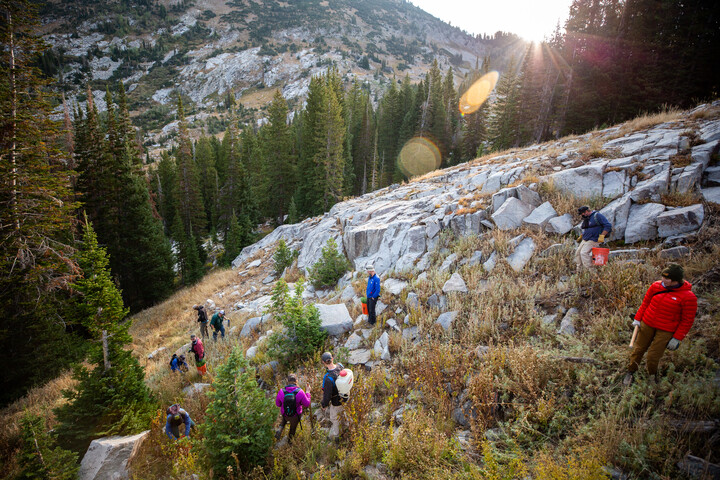
Based on field assessments and resulting management recommendations and direction from the Forest Service, Alta focuses on management of diseased, damaged, and hazard trees which includes removal of trees that may harm persons and property; forest thinning activities to regulate stand density and encourage ongoing regeneration of forest resources, and promote long-term stand health; maintaining groomed ski runs which includes harvest of small saplings within groomed runs that are replanted elsewhere in the ski area; and the collection of tree seed from more resilient tree species which include Engelmann spruce (Picea engelmannii), Douglas fir (Pseudotsuga menziesii), and limber pine (Pinus flexilis) for tree planting within the ski area. These species appear to be less affected by beetles and pests compared to species such as subalpine fir (Abies lasiocarpa) which are highly impacted by beetles and pests. As the forest continues to be impacted by pests and other factors, Alta will continue coordinating with the Forest Service to determine evolving management objectives.
Weeding Those Pesky Invasive Species
Another major component of our land conservation program includes noxious and invasive plant species management which is a partnership effort between the AEC, FOA, and CCF. Surveying for and pulling noxious and invasive species helps keep the plant community within Alta healthy. Invasive plants thrive in disturbed soils and are often found along roadsides and in the base area where foot and vehicle traffic is greater. These species often out-compete native vegetation due to their rapid growth and may over-shade native vegetation, increasing competition and reducing plant diversity. The spread of invasive plant species threatens the larger ecological balance of Alta’s delicate alpine environment and can also reduce soil stability, which may impact the protected watershed. Every summer, the AEC and its partners survey over 100 acres within the ski area and the Town of Alta (TOA) to document and remove invasive plant species for a healthier environment and ecosystem.
Summer Recreation
Each summer presents its own opportunities, changes, and challenges. Overall, it was another enjoyable summer in Alta. Here is a rundown of the results:
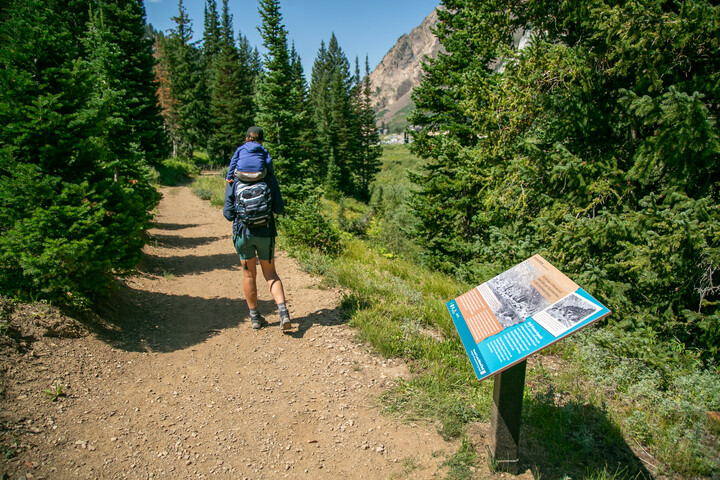
Summer Road
- Visitor management operations began on June 25 and closed on October 8 due to snow.
- The fee booth was staffed for a total of 89 days of the total 105 days of 2021 summer. The remainder of the days that the road was open, it operated on a self-pay system called the iron ranger.

Visitation
- A vehicle count was collected in the TOA. 67,905 vehicles were counted during the summer season.
- Of the 67,905 vehicles, 25% continued up the summer road into the Albion Basin.
- The Albion basin parking lot was able to stay open for the entire summer for visitor parking. With this, Alta was able to open bathroom facilities 7 days/week during peak summer visitation.
- The Alta Summer Host program was well represented after last year’s Covid summer. 65 days of visitor engagement data were collected amongst Alta’s summer hosts comprised of CCF, FOA, and Ski Area staff as well as the Forest Protection Officer (FPO). Within those 65 days, 5,017 engagements were made with visitors of Albion Basin.
- 70% of all engagements recorded covered environmental education topics, while the remainder covered hiking and trails, flora and fauna, and protecting the natural watershed.
Protecting the Wildflowers
Recreation in the Albion Basin has seen a substantial increase over the last couple of years, and for good reason: The beauty of the wildflowers that bloom at the top of Little Cottonwood Canyon is one the most incredible seasonal transformations that occur in the Wasatch. But, this increase in visitation comes with a price - unfortunately, it is coming at the price of the wildflowers themselves. Those looking for the perfect photo amongst the flowers are creating non-designated trails and trampled, barren areas. We recognize that the desire for these photos and the AEC is working on creating designated spaces for visitors to do so, contingent on Forest Service approval.
We have proposed to establish photography pull-off locations along the Albion Meadows Reroute trail (trail 11 on the Trail Map). These pull-off locations will allow for photographers to capture that “immersed in the wildflowers” look while conserving the beautiful wildflowers for future visitors.
Photos Below: Designated photography pullouts along Albion Meadows allow you to get the shot while conserving the wildflowers for future visitors.
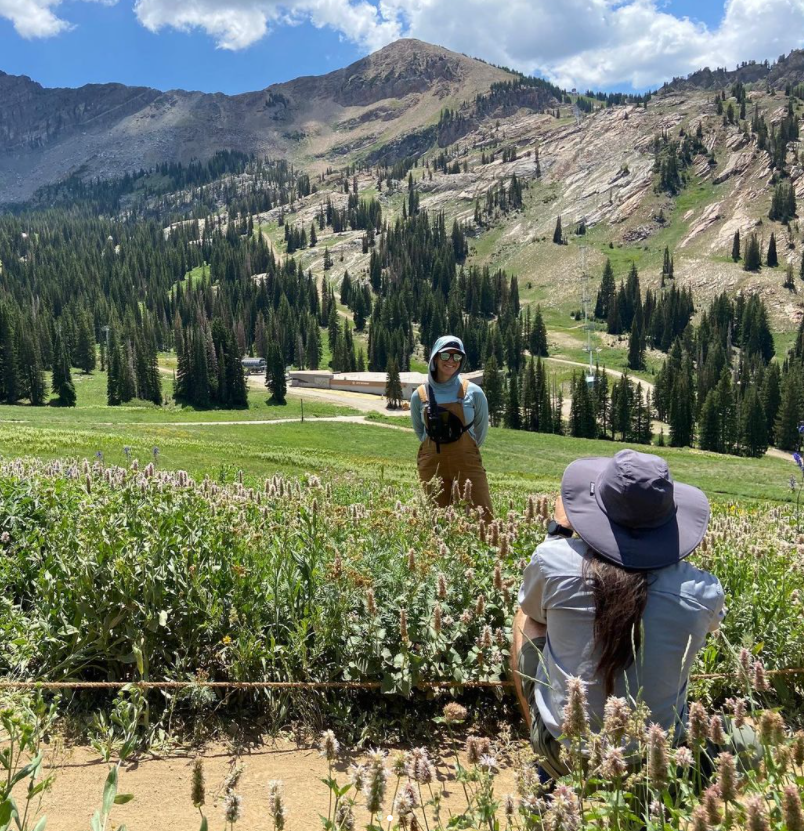
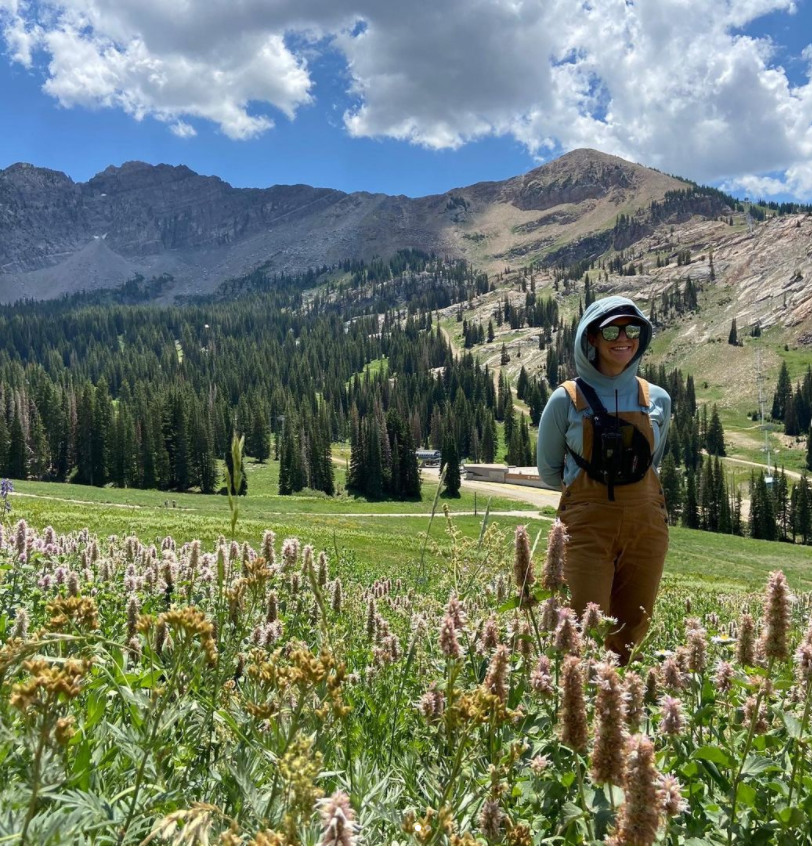
Trail Work
The AEC has focused on improving and expanding the Forest Service trail system within the Albion Basin over the last few summers. Our efforts have paid off with new routes installed in the Albion Basin which offer more loop options for recreationalists. Our focus has been on the Albion Basin due to the increasingly high volume of recreationalists we are seeing year after year in the summer. Most of these recreationalists are drawn to the spectacular wildflowers of the Albion Basin or the beautiful views of Cecret Lake and the Devil’s Castle. By offering more hiking route options, this helps to distribute users and protect the natural resources by offering additional official trails for user enjoyment.
The AEC installed one new trail in the Albion Basin this summer with the help of CCF. The new Homerun trail was installed to create a more sustainable and enjoyable route through the Homerun area and to help further distribute users and decrease user conflict in the Albion Basin. This trail also provides another loop option in the Albion Basin. The area where the new trail was installed is described as an old straightaway service road. Alta created a more fun and interesting trail complete with twists and bermed turns. The remainder of this trail will be completed in spring/summer 2022 and will be ready for action by mid-summer 2022. Additionally, the AEC completed construction of the trail that commences from where the Alf’s Road meets the Summer Road and continues to the Cecret Lake trailhead, and offers an alternative to walking on the road. The trail itself was installed last summer; however, this trail crosses a stream channel which required installation of a Forest Service-approved bridge to protect the water resource. Thanks to our summer ski patrollers and AEC staff for building and installing the bridge this summer for summer visitors to enjoy!
Maintaining and improving upon the trail system includes installing reroutes and completing restoration of existing trails. You may see areas where trails used to be that are now marked as “habitat restoration” areas. These are areas that have been decommissioned that we are actively trying to restore. A trail may be decommissioned because it was not originally built in a sustainable manner and is experiencing erosion issues, or because an existing trail no longer supports long-term trail system goals. Please help us out by staying on official trails and respecting closures.
Improving the trail system in Alta is an ongoing process. We look forward to incorporating more community feedback and involvement on the trail system in the future, so keep an eye out for these opportunities going forward.
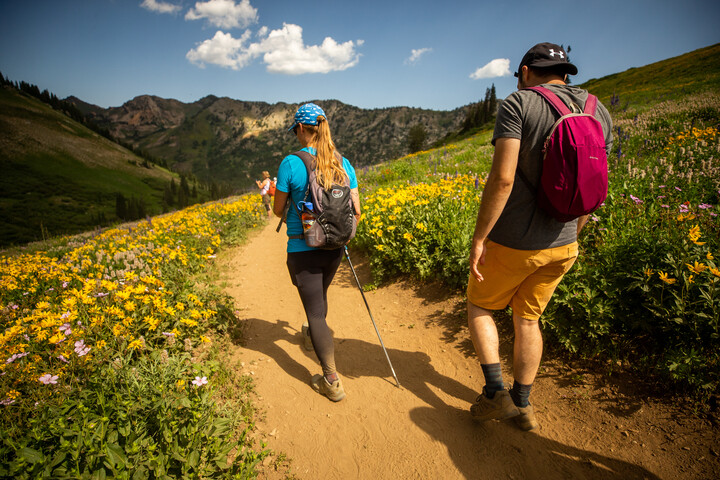
BEING GOOD STEWARDS
The beauty of an Alta summer draws many visitors to the ski area, most notably to the Albion Basin. We welcome all to come take in the beautiful wildflowers and mountain view; however, it is imperative to remember to be good stewards while recreating in Alta, and anywhere else. What exactly does being a good steward mean? Being a good steward means that you are experiencing the environment in a responsible and respectful manner while implementing conservation and sustainable practices to reduce impacts to the natural resources and environment. It means staying on official trails, staying off the vegetation, protecting water resources, respecting wildlife, abiding by rules and regulations, and leaving the natural resources as you found them.
It is up to us to preserve the experience of visiting Alta and allowing future generations to enjoy Alta’s beauty.
As the population in the Salt Lake Valley continues to grow and as more people make their way up to Alta, it is increasingly important to take into account not only our individual impacts, but our cumulative impacts.
Cumulative impacts are impacts caused by past, present, and future users. While an individual may not think their individual actions have a major impact on the environment, the collective actions of everyone add up over time. One person stepping off trail may not cause a noticeable impact; however, repeated stepping off trail in the same area by various individuals has resulted in compacted, unvegetated areas over time, especially in the Albion Basin.
Over the years as summer visitation has increased, different measures have been implemented to try and address increasing user impacts while preserving the Alta summer experience. Signage around the ski area aims to educate the user about the fragile alpine environment, the protected watershed, the wildlife that call Alta home, and the importance of reducing impacts on natural resources. Implementation of an Alta Summer Program to manage summer visitation in Alta has been an ongoing program for several years. The summer program includes naturalists that roam around the ski area or are stationed at the base area to answer questions and educate visitors. Wooden stakes with roping have been installed along heavily used trails that see the most impacts to encourage users to not step off of the trail.
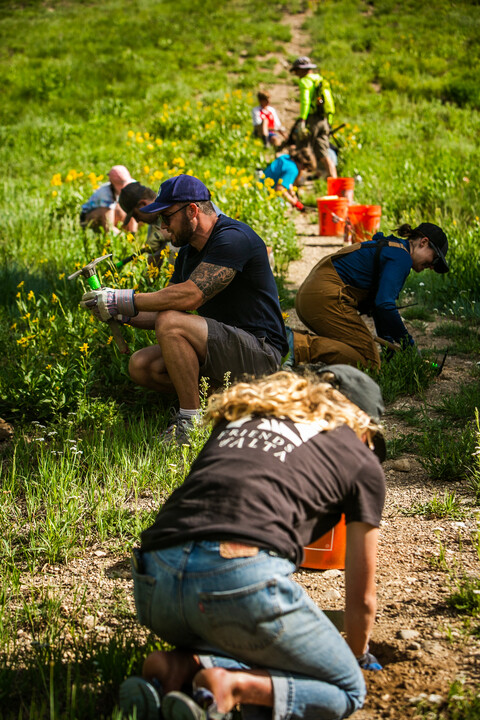
Our future conservation and natural resource protection efforts include a multi-level approach including education, signage, engineering, and engagement. For the summer of 2022, the ski area plans to designate photography pull off locations within the Albion Basin (contingent on Forest Service approval). The Albion Basin is a popular place for photographers; however, impacts from photographers are becoming increasingly apparent. Where there were once dense wildflowers, there are now areas of bare, compacted dirt void of native vegetation due to repeated stepping off trail. Establishing photography pull offs will help to reduce impacts in the Albion Basin from off trail use and provide photo locations where photographers can capture that “immersed in the wildflowers” look. In addition, more effective stakes and roping will be installed in the heavily used areas of the Albion Basin to help emphasize the importance of staying on official trails. This will be complimented by updated summer signage around the ski area to replace and update outdated information and further emphasize protection of the natural resources. With these additional summer conservation measures and everyone’s cooperation, we can continue to preserve the Alta experience for many generations to come!
Summer Stewardship
The AEC was thrilled to host summer volunteer and stewardship events after having to put these efforts on hold in 2020. This summer, over 20 volunteer, stewardship,and educational events were held here at Alta. Summer events included live birds of prey brought to the Alta Town Park by HawkWatch, monthly birding hikes led by a conservation ecologist from Tracy Aviary, and on-the-ground conservation events in which hundreds of volunteers showed up to donate their time and labor. Together, we planted 1,000 trees and over 5,000 plants; removed invasive species from areas all over the mountain totaling over 100 acres; and harvested approximately 165 Engelmann spruce saplings from groomed runs for replanting elsewhere on the mountain.
Our intent by hosting these events is multifaceted - the task of maintaining and conserving the environment around us is quite a large undertaking and we can’t do it alone. Our volunteers and partner organizations make this effort possible. By creating a connection to this place, we are in turn building a sense of communal responsibility in conserving the natural environment for generations to come. Thank you to each of our volunteers, our employees, our non-profit partners and everyone in between who donated their time to us this summer. We are so grateful for the connections and impacts made. We look forward to hosting you all in summer 2022!
alta's carbon footprint
A key part of Alta’s sustainability strategy is understanding the need to address the challenges posed by a changing climate, especially as an industry that relies on a stable climate and for snow to fall. Alta Ski Area set a goal through the National Ski Area Association (NSAA) Climate Challenge in 2010 to reduce our greenhouse gas
(GHG) emissions by 20% from 2010-11 levels by 2020-21. Previous to the 2019-20 ski season, Alta had achieved an 8% emission reduction from 2010-11 GHG emission levels in the 2018-19 season. While we recognize that we haven’t met our emission reduction goal to date, we have at least reduced our GHG emissions over time.

Alta has addressed several turnkey efficiency opportunities at the ski area over the years including efforts such as replacing lighting with more efficient lighting and installing automated light switches and faucets. Major sustainability initiatives at Alta have included:
- Construction of a Leadership in Energy and Environmental Design (LEED) silver-certified building in 2012. Construction of this building included a central plant efficiency upgrade, use of sustainable building materials including carpeting and paint, installation of automated heating controls, and installation of water-conserving fixtures.
- Installation of 98 solar panels in 2015; on average, the solar panels produce just under 1% of Alta’s annual electricity use.
- Implementation of food waste collection programs in 2019 and 2021 has resulted in 11.7 tons of food waste diverted from landfills to date.
- Installation of two electric vehicle charging stations, one in the Wildcat parking lot and one in the Albion parking lot.
- Purchase of two Pisten Bully 600 E+ snowcats (“green groomers”) which use 20% less fuel and produce 20% fewer carbon emissions compared to conventional snowcats.
As we continue to see the increasing impacts of climate change all around us, our efforts to reduce our GHG emissions continue. Given that electricity makes up at least half of Alta’s GHG emissions, sourcing clean and renewable energy for our electricity needs is an opportunity to clean up our act.
Beginning in January 2022, Alta will purchase renewable energy credits (RECs) in an amount equivalent to its annual electricity use through RMP’s Blue Sky program.
This will provide support and additional demand for renewable energy while reducing Alta’s carbon footprint. Additionally, this will provide flexibility for Alta to implement other sustainability initiatives in the future that are more attractive, effective, or a better fit for the ski area, such as procuring renewable energy through a power purchase agreement. Alta sees the need to act now but will continue to refine its sustainability strategy going forward as new opportunities become available.
Food Waste Collection
Alta and Snowbird have partnered with Momentum Recycling to haul our food waste to Wild Harvest Farms. At Alta, it all started in the spring of 2019 when the five kitchens at the ski area (Buckhorn employee kitchen, Alf’s, Watson Shelter, Albion Grill, and Collins Grill) participated in a 2-month pilot program to collect and divert food waste from the landfill to the Wasatch Resource Recovery food digester. A second pilot program for food waste collection was implemented in March and April 2021 at all five kitchens at Alta with the intent of implementing a permanent food waste collection program going forward. This time around, Alta coordinated with Snowbird to use the same waste hauling service, Momentum Recycling, and to send food waste to the same large-scale composting facility, Wild Harvest Farms. To date, 11.7 tons of food have been diverted from the landfill at Alta.
Why divert food waste from the landfill? When food waste sits in the landfill, it generally becomes covered up by other waste which creates an anaerobic (oxygen-deficient) environment. In an anaerobic environment, food waste cannot break down and methane is released as the food continues to rot in the landfill. When food waste is sent to the composting facility, an aerobic (oxygen-rich) environment is created which allows the food waste to break down. While carbon dioxide (CO2) is still a byproduct of composting, CO2 has a much lower global warming potential (GWP) than methane. Methane is estimated to have a GWP of 28 to 36 over 100 years, while CO2 has a GWP of 1 over the same time period. By sending our food waste to Wild Harvest Farms, we are lowering our greenhouse gas (GHG) emissions and also helping to create a nutrient-rich fertilizer that can be used in gardening and farming operations, resulting in a zero-waste process.
The ski area looks forward to continuing this program during the upcoming 2021-22 winter season. Additionally, this season the Goldminer’s Daughter Lodge and the Alta Lodge are starting up food waste collection. It is great to see this sustainability effort spread within the Alta community!
winter 2021-2022
We were thrilled to see many returning participants, and many new faces, attend our winter events during the 2020-2021 ski season. Our intent with winter events is to create a fun-filled experience that highlights the beauty and importance of Alta’s natural mountain environment. Education and stewardship opportunities in every season are vital to learning about and conserving the environment at Alta. We make the biggest collective impact when we are able to connect with the members of our community.
Birding on Skis
Our small canyon is home to over 100 different species of birds, an astounding number for such a small area. Bryant Olsen, a conservation ecologist from Tracy Aviary, hosts this twice-monthly event which consists of skiing around the mountain and observing bird behavior. His extensive knowledge about this environment leads to a well-rounded tour through the trees and powder. This year’s tours will occur on the second and fourth Thursday of every month, December through April. Please check our website for registration! Space is limited.
Snowshoe with a Naturalist
Snowshoeing gives Alta visitors another avenue to explore, learn and have some fun in the canyon without skis. Our partners at CCF are the true heroes of this event; trained and educated naturalists come up to lead the tour, and give some great insight into the ecosystem of Little Cottonwood Canyon. We also had the privilege of hosting Wasatch Adaptive Sports members and their families on more than one occasion. Registration is required through www.cottonwoodcanyons.org/events/.
Ski with a Ranger
CCF volunteer naturalists lead free “Ski with a Ranger” tours at Alta Ski Area (and at the other Cottonwood Canyon Resorts) on Saturdays to bring adventure and learning together. A family-friendly activity on beginner and intermediate runs, CCF’s knowledge sheds light on the unique ecosystem that lives and breathes here at the top of Little Cottonwood Canyon. Meet at the top of Sunnyside lift a 1pm every Saturday, January 8 through March 26.
Trees and Skis
The gentle giants here at Alta tell a story - one that can be told by an arborist from TreeUtah! Take a short tour through the trees with an arborist from TreeUtah. Skiing through the trees and seeing what truly lives here brings a fresh perspective to these slopes. Meet at the top of Sunnyside lift at 1 pm every 3rd Wednesday of the month, beginning January.
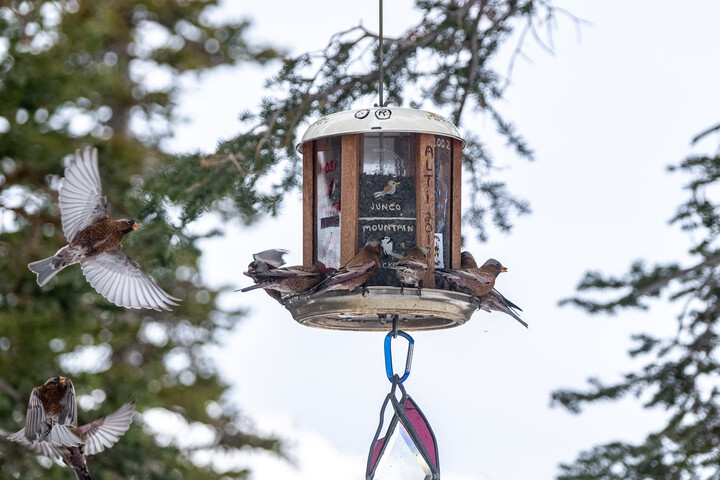 Winter Event Dates
Winter Event Dates
Birding on Skis
2nd and 4th Thursday of the month, December through April. Registration required on Alta website.
Snowshoe with a Naturalist
January 21, February 18, March 18, and Alta Earth Day in April. Registration required at cottonwoodcanyons.org/events/
Ski with a Ranger
Every Saturday at 1pm from January 8 through March 26 at the top of Sunnyside lift. No registration required.
Trees and Skis
3rd Wednesday of the month, January through April. January 19, February 16, March 16, and Alta Earth Day in April
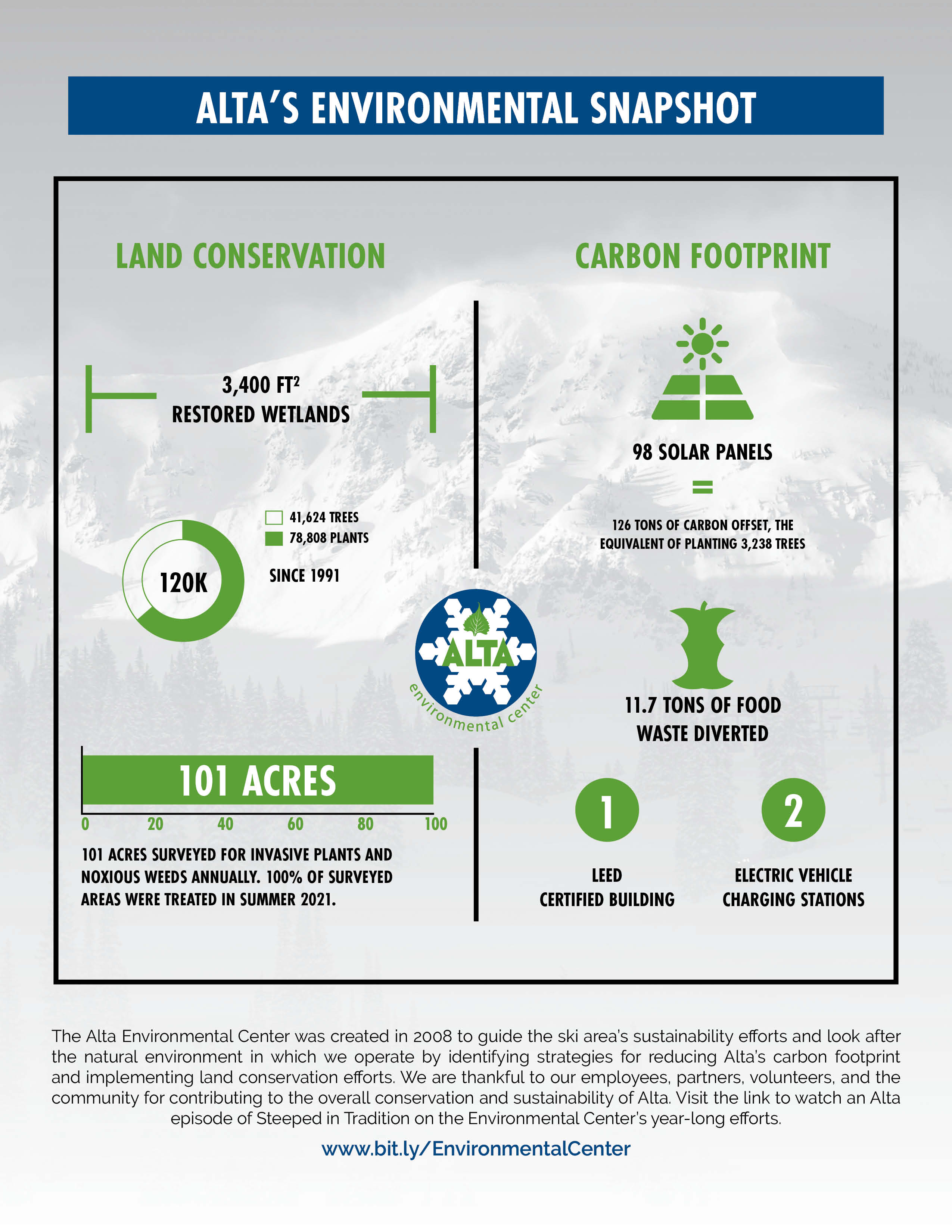



Comments